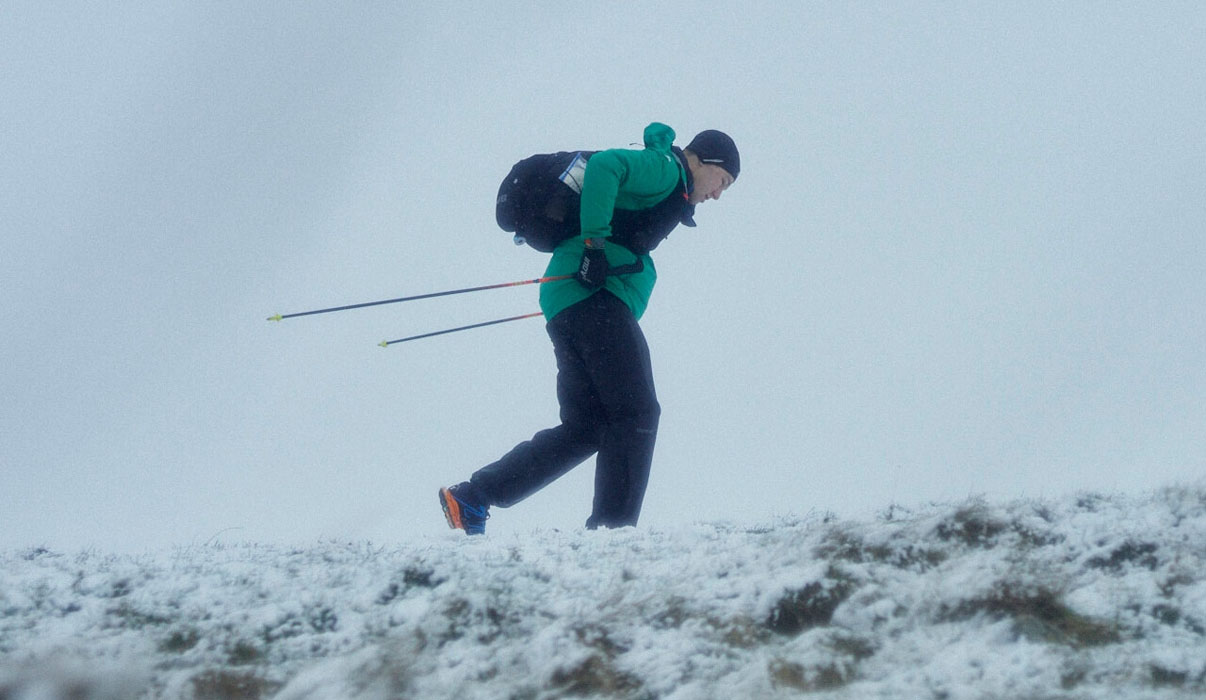
Jack Scott wrote himself into history at the 2024 Spine Race, with a performance fellow competitor Damian Hall called “one of the great performances in British ultra-running history”. Jack shattered Jasmin Paris’s record for the 268-mile course by more than 10 hours, running 72 hours 55 minutes in a perfectly executed race.
Now he’s recovered and slept (Jack had less than an hour’s sleep in the whole three days he was racing!), Jack’s ready to share how he trained and prepared for the race. You’d expect his build-up to have been perfect – but that was far from the case. Hampered by injury, he did a lot of work in the gym, managing niggles to get himself to the start line in one piece…
HOW I TRAINED FOR THE SPINE RACE 2024
After a successful run at the Spine in January 2023 (2nd place) I was eager to return and felt I’d earned the right to “race” it this time. My spring and summer had been a success, I’d peaked for every event I’d entered, bar the Ultra-Trail Snowdonia 100K which wasn’t my finest hour (5th place).
The fell races I’d entered went superbly, with local wins and course records in the Peak District. I then followed this up with strong showings in the more competitive Lake District races. The fell season was over for me in November after a 2nd place finish at Pendle Hill. Another consistent, strong and satisfying performance but it was time to leave the lunatic/kamikaze hill racing scene behind and focus on the goal of getting into a strong and stable place before the Spine Race 2024.
Five days after Pendle I was on the Pennine Way and ran a 54-mile training run. Carrying full kit for the first time in the year and accompanied with horrendous weather, I ran from Gargrave to The Tan Hill Inn. Unfortunately, my body let me down here. I had unusual fatigue and shudders down my IT band. From the Sunday morning after the 54, all the way to Edale and the start of the race in January I found training extremely challenging.
In December I woke up every day with an issue of some sort. Whether that be my Achilles, ankle or a dull ache from a bursa on the inside of my knee. Luckily the IT band issue vanished after a 10-day stint of clever, patient training in the gym. All the other restrictions could be managed, but it was unpleasant and for the first time in 6 years I wasn’t able to do what I wanted in training.
To put it into perspective, there were only two days in December where I ran back-to-back. These were however, superb days on the Pennine Way, Saturday was the 39 miles from Alston to Bellingham and Sunday was the final 27 mile stretch from Byrness to Kirk Yetholm. This was the weekend of 9th/10th of December, so five weeks out from the race. The 39 on the Saturday was probably the best training run of that distance I’ve ever managed to do.
I took note of what was good and what was bad, working on my weaknesses in the gym. In December I logged over 15 hours of gym work and this helped keep me sharp without loading the body with any unnecessary mileage or stress, trying to let those niggles settle. All the time I was thinking: “survive the training block, be resilient and the race is the treat”.
UPHILL TREADMILL POWER HOUR
There was a session I brainstormed and executed a few times which I thought was extremely effective. It's the Uphill Treadmill Power Hour:
- Short warm up of 5/8 minutes.
- Start the treadmill and get to max incline as fast as you can (usually 30 seconds). On the treadmill I used this would be 25% incline.
- For the next 60 mins keep the treadmill on this incline, all you’ve got to do is keep moving uphill (reducing the pace if you need to).
The pace I’d manage during the hour would vary. The minimum pace would be 5.4 kmph (17:54/mile) and the maximum would be 7.2 kmph (13:24/mile). A session like would generate between 4500-5000ft of climb and cover no more than 3.8 miles. The average pace across all my Treadmill Power Hours was 16:09/mile.
What I was doing here was working at Spine Race pace (my average for the 72:55 race time was 16:15/mile) but also exploring a very high intensity session for my heart and lungs (my heart rate would easily be above 175 for 50 minutes during a session like this). I was keeping fit and training race specifically. The sessions were tough and my elevation stats went through the roof, but the mileage was low and manageable.
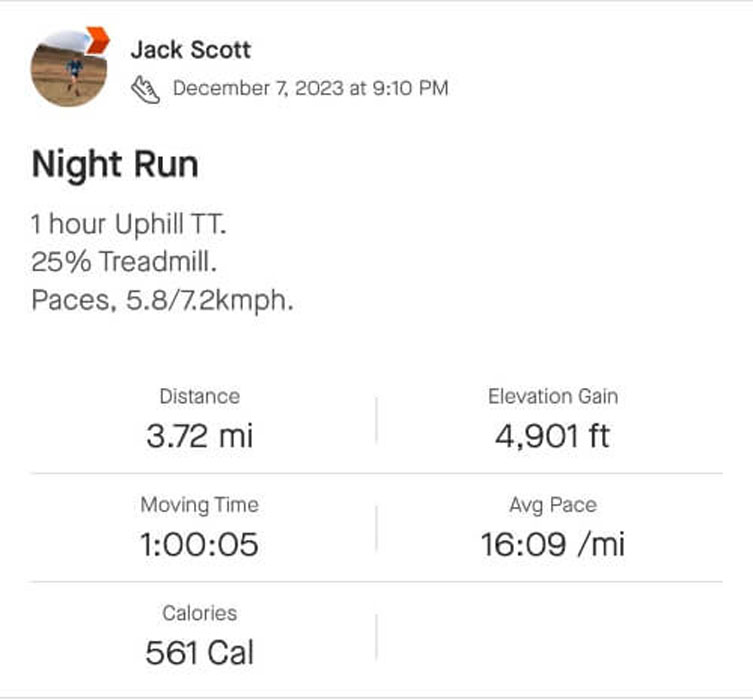

AVERAGE WEEKLY STATS
For the Spine 2024 training camp I averaged 52 miles a week with 11,000ft of elevation, accompanied by five gym sessions.
This got me to the start line fresh and well below the overtrained line, with a willingness to suffer when I needed to. I was happy, healthy and ready. I closed my circle in tight, I declined media opportunities and I came off social media.
I kept a focus and clear vision of touching the wall first. The introduction of huge names to the start list was a blessing for me. If I was going to run the race I knew I was capable of, then there was no better year to prove it than 2024.
“Jack’s run was incredible, he really nailed it in every way. The ground was hard which I think will have helped, but he also ran really fast and hardly slept. He was super-consistent the whole way, which is unbelievable given how little sleep he took. Huge congratulations to Jack.”
Jasmin Paris, Spine Race Winner 2019 and former course record holder
HOW I PREPARED FOR THE DEMANDS OF THE RACE
Last year was the perfect dress rehearsal and I didn’t need to do anything differently in training this time round. I simply wanted to come in happy and healthy with a quiet, steely confidence.
I was wary of a return because 2023 had gone so well that I wanted to protect that performance and not jeopardise it. I worked with my psychologist and he helped me realise that to run the race I knew I was capable of, I had to analyse last year.
To do that I needed to extract the positives and negatives then leave it alone and start afresh. The run and the memories would still be within me, but I didn’t need to have them at the forefront of my mind, I needed clarity and focus for this year’s race. No tash this time, a new Jack.
Alongside some tweaks to kit, I did the most basic but overlooked thing of all: I got better at running slower, in the dark, on the course. I believed I could win the race and did the calculation that If I moved 0.1 miles an hour faster I would come in at 82 hours.
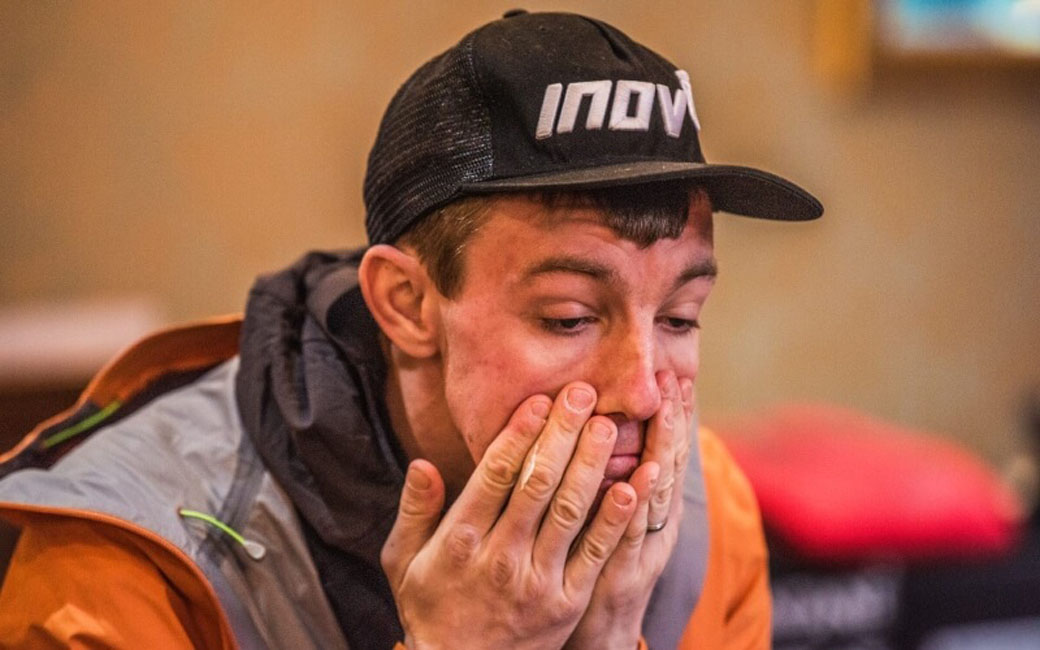

SLEEP
Much has been said about my lack of sleep during the 2024. But in preparation I kept it simple and didn’t specifically plan to run the race on less than one hour’s sleep!
That said, I knew I wanted to make it to Checkpoint Three at Langdon Beck before sleep. If I was struggling before then and had to shut my eyes, then the likelihood is I would lose touch with the leaders and leave myself too much to do in the second half of the race. My plan was:
- Stay awake
- Assess the race every hour
- Make decisions at the time with the information and feelings in front of me
“I really believe that is one of the great performances in British ultra-running history. To win like that and beat Jasmin’s record by so much, is incredible.”
Damian Hall, Spine Race Winner 2023
THE KIT I USED TO WIN THE SPINE RACE
For 2024 I tweaked a couple of things regarding kit:
- I improved my watch and raced with the Suunto Vertical with the aim of avoiding the navigation errors I made in the 2023 race
- I got a more fitted race vest instead of a chunky pack
SHOES
The standout piece of kit for me was the single pair of TRAILFLY G270 V2s I used for the whole race. I had trained in this shoe, but not a lot. The pair I wore were a size 10 and 0.5 bigger than I’d usually go for. At the start line they probably had around 130 miles of wear in them. They are magnificent and after winning some fast and furious mountain races in the G270s, it felt fitting to work together and churn out the mother of all long-distance trails in them.
Editor's note: The TRAILFLY G 270 V2 is no longer in the INOV8 footwear range with alternatives being the TRAILTALON SPEED and TRAILFLY SPEED.
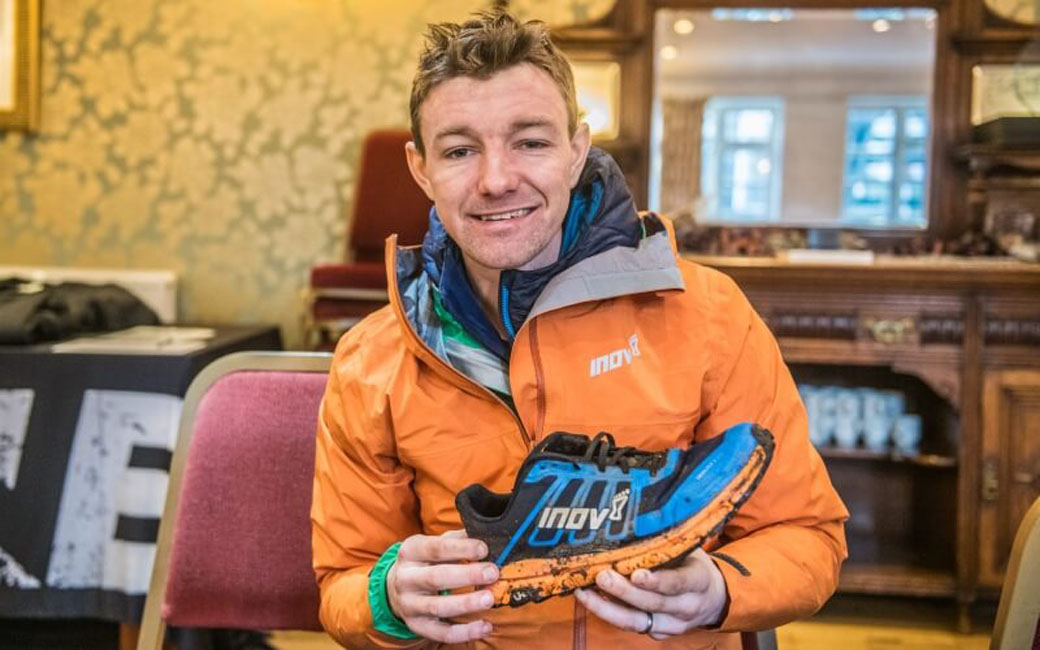
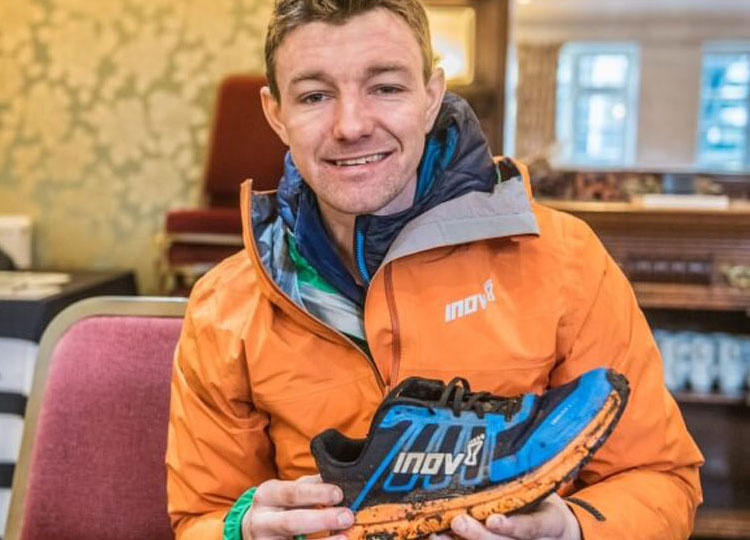
CLOTHES
In late summer INOV8 released the PERFORMANCE HYBRID Jacket. I was training in Snowdonia with Damian Hall when he donned one as we ate dinner. He asked if I’d picked one up yet. I hadn’t, but I was sending emails that next morning to get my hands on one. I wore this jacket for over 140 miles during my race and it dealt the deep cold and sharp breeze of Cross Fell superbly. I struggle with skin irritations, but I’ve taken to this jacket like a pig to poop. A great investment that will stand the test of time.
My INOV8 TRAIN ELITE Gloves and Hat worked very well in 2023 and again in 2024. They supply the basic layer of protection from the elements and compliment a more heavy-duty bit of kit when its needed. I had some high-end RAB climbing gloves to hand when the temps got below -6C and they fitted nicely over my lightweight INOV8 gloves underneath.
PACK
Being able to store everything on your back and not need a waist belt eradicates any rubbing/chaffing issues. The INOV8 pack I used this year is a proto of the new RACEPAC 20. It’s a 20L vest which easily held all the 31 pieces of mandatory kit and still had shoving space for more. The race fit is something I preferred to the expedition type pack I wore in 2023.
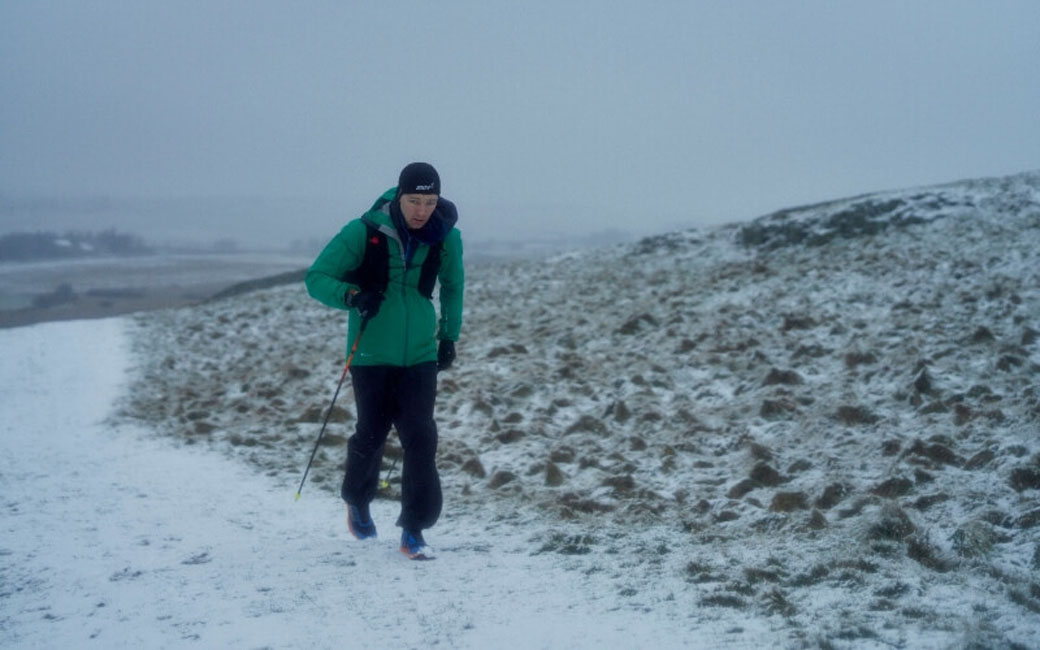
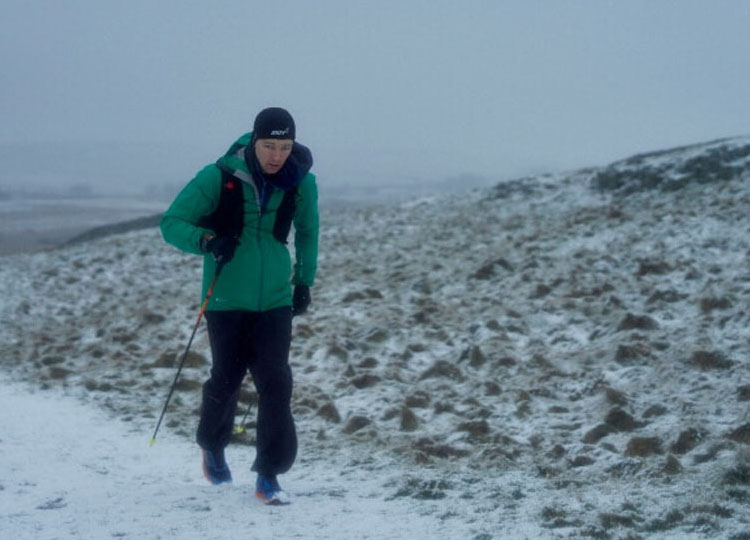
HEAD TORCH
The light at the end of the tunnel is the Fenix HM65R 1400 Lumens head torch. After reading some reviews and speaking to some like-minded long distance odd bods, I opted for this brand over my Petzl from the year before.
I’d had issues with my batteries in training this year and didn’t trust the percentages of charge shown. For clarity I brought the Fenix. In times of need, like a huge open space where there’s a stile in a random corner of a field, you can fire it up to turbo and see everything.
But for 90% of my race I had it in setting three (high). The data suggests the head torch will last 22 hours @ 400 lumens, which is exceptional. I was sensible though and accounted for the windchill factor (colder weather reduces battery life). I thought even if I lose 20% of the battery capabilities, the torch will have more than enough to see me through the dark hours.
TIP: If buying spare batteries, purchase the Fenix official ones. There are cheaper options but on the Pennine Way, after 50 hours of racing and with a windchill of -15C, you won’t care about £10 extra for a legitimate battery!
TO CONCLUDE
In the days after the race I’ve tried to piece together how and why my race went as well as it did. I spoke to people who know the sport and have seen things before to try and latch onto a nugget of information that would explain how I’d managed to run in the footsteps of legends, names that surpass mine and come out with such a huge margin of victory.
The conclusion I’ve come to is that I was in the right place, at just the right time, doing precisely the right thing!
